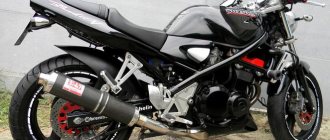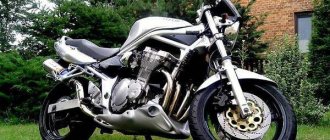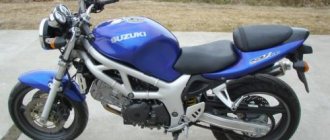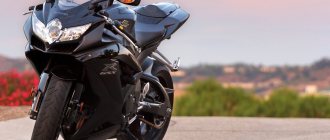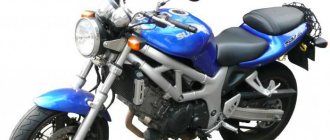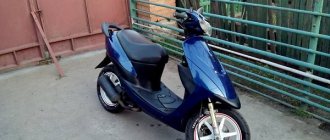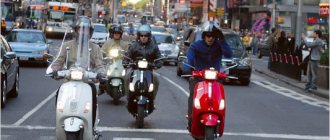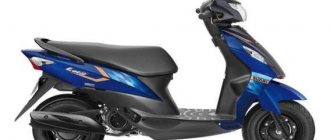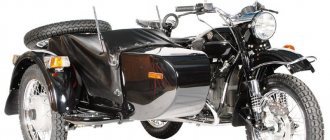Speed is speed, but when you need to get from point A to point B relatively quickly, with comfort and a bunch of things, a maxi-scooter becomes an indispensable two-wheeled vehicle. “Couch” wars have their own leading group. In terms of equipment and overall dimensions, the Burgmans confidently dominate.
The Japanese are smart guys - the same scooters in Europe, America and Russia are called Suzuki Burgman, and in Japan Suzuki Skywave. Not that there is any confusion, but you must admit that “cloudy sky” (free translation of sky wave) sounds much more pleasant than the almost abusive “burger” (no less free translation of burgman).
Of the big Japanese four, Suzuki is more fond of modernizing everything ten times, and then once again modernizing what has been modernized. Hair in all places moves with enviable frequency among those who maintain it all, service it and order parts. From the complete list of changes made, it is possible to publish a rather large three-volume book. Today we will touch only on the most significant ones.
All Suzuki motorcycles (and scooters are no exception) have internal numbering according to the year of manufacture of the type K1, K2, K3, etc. The starting point is 2000. Since 2010, “Burgs” have moved to the next letter L in the alphabet. As for the versions for different markets - they usually differ in small details, such as instrument panel calibration (American versions operate in miles and gallons), electronic settings and various environmental “bells and whistles”.
We will not consider “small things” such as the Suzuki AN200, AN150 and AN125 Burgman. These identical and rather primitive scooters are at the forefront of the Burgman food chain. They have never been particularly popular and are not widely used in Russia.
Economical and great scooter
Despite the average powertrain performance, the Suzuki Burgman 200 is definitely a maxi-scooter. Motorcycle-style suspension and ride safety features make it a great city commuter scooter for everyday commuting, shopping, and weekend trips. So this is not just a well-fed 200cc moped, but a completely universal and serious transport. Let's find out what the plastic of the smallest Burgman hides.
Design
Suzuki Burgman 200 sports the same appearance as its older brothers - a wide front fairing, a high and strong windshield that protects the rider from rain and insects, allowing the oncoming flow above the head. Flush-mounted turn signals on either side of the dual headlights give the front end of the vehicle a somewhat sporty look. The front plastic protects the radiator of the cooling system and protects the legs from any road troubles.
The dashboard of the Suzuki Burgman consists of two dial instruments located deep under the visor and displaying various important information. There's also an Eco Drive warning light that lets the rider know if he's driving too fast or too slow for fuel economy. Much like a light bulb indicating that it’s time to shift up or down a gear, only not for the gear, but for the throttle.
On the driver's side, the front plastic of the scooter has two compartments for gloves and small items, as well as a 12-volt socket, so connecting a navigator or phone will not be difficult. A low tunnel on the floor of the scooter does not create any inconvenience for boarding, but reduces the “luggage capacity” between the rider’s knees, since a high load cannot be placed there.
The scooter's seat positions the rider's rear seat at a comfortable 734mm, and has a nicely narrow shape at the front that doesn't force the rider to keep their feet too wide apart, at least when they're on the floor of the scooter rather than on the ground. The device is very comfortable for short people, but for those who shop in the Big-and-Tall sections, it will be a bit cramped.
The passenger part of the seat is significantly higher than the driver's, thanks to which it simultaneously becomes something like a backrest for the driver and makes the passenger sit higher. The design of the passenger footrests is no different from the driver's - they are long and wide platforms along the device, which, of course, is better than the flimsy retractable footrests we are familiar with in simpler scooter models. As usual, the seat reclines to provide access to the luggage compartment, which, according to the manufacturer, can accommodate two helmets, but you need to keep in mind that large helmets or large modular models will not fit there.
Passenger handles complete the amenities for the second room. The wide rear of the scooter is equipped with flush-mounted paired light signals, suitable for any vehicle - side lights, turn signals, brake lights. Mudguard - the license plate holder protects others from splashes from under the rear wheel.
AN250/AN400 Burgman (1998 – present)
In the beginning there was the word... and the Suzuki AN250 Burgman, which became the first-born among the “Burgs”. At the time of its appearance (1998), in terms of cubic capacity, it normally fit into the maxi class. The device turned out to be practical, moderately nimble and comfortable enough for two people to ride. A single-barrel gun with a working volume of 249 cm3 with a conventional V-belt variator was installed in a tubular steel frame. The suspension and combined brakes generally correspond to the potential of the engine. This means that the skinny shock absorber and the equally skinny telescopic fork can handle the body of the scooter properly, but it’s better to avoid aggressive driving, if at all possible.
With maxi-scooters, like with cars, differences in generations are usually divided into bodies. Together with the 250, it immediately makes sense to consider the AN400, since both cubic capacities are made on the same base and are closely intertwined with details and development history. In theory, you can even exchange their engines, but in reality the labor costs will cover all possible bonuses.
The Suzuki AN400 Burgman appeared a year later, in 1999. Like all “scabies,” this is a purely domestic Japanese model that has gained popularity in Europe. In fact, the Burgman 250 was taken as a basis, the cylinder displacement of which was significantly increased. Otherwise, the brothers in the model line have the vast majority of interchangeable parts (of course, similar years of manufacture) - much of the engine, suspension and brakes, frame with engine mounting points, plastic, dashboard. The differences are in the CPG (the engine crankcase has not been changed), intake and exhaust, variator (reinforced on the 400), electrical wiring (the brains of the 250 do not have an ignition corrector for the carburetor throttle position) and some small details. Also, on the AN400, unlike the AN250, a decompressor is installed, since the starter from the “check” is not able to crank the engine of the “400” without it. From 1998 to 2006, the AN400 was equipped with a convenient pneumatic rear shock absorber adjustment system. Starting from 2007 (K7 and higher), the same simple shock absorber is installed on the scabies as on the 250s. 2007 generally significantly erased the minor differences between the two cubic capacity.
Body 41 (since 1998) is one of the most popular on the secondary market and disassembly sites. Visually it is the most primitive. Characteristic features are black plastic under the windshield (the so-called “boomerang”), almost straight handles for the passenger, a thin passenger backrest cushion and a brake light sadly looking diagonally down. From a technical point of view, there are complaints about the ever-flowing carburetor that requires frequent maintenance (age is taking its toll), the absence of a tachometer on the dashboard, and the rear wheel being mounted on splines like a fifty-kopeck scooter. The last point is especially important. The splined design definitely did not justify itself under the loads of a maxi-scooter. During sharp starts, the thin metal protrusions quickly deform, taking the rear wheel disc with it.
The 42nd body (since 2001) is a job of making mistakes. Visually we can distinguish it by more comfortable curved handles for the second number, a boomerang in color, deflectors in the engine area, thicker backrest cushions for the driver and passenger, as well as a more rapid tail with a modernized “stop”. The frame was modernized to accommodate the updated rear end. All the “sores” of the 41st body are also true here.
The next in order body 43 (from 2003) is not yet a complete transformation, but it is already close. Appearance has changed noticeably. The facings have become smoother and more rounded, the equipment has added two glove boxes on top, and the glove box at the bottom has been enlarged; a tachometer can already be found on the instrument panel. The headlight became double. The volume of the gas tank has increased. The engineers finally got to the two main weak points. So the capricious carburetor was replaced by an injector, and the rear wheel is now mounted not on splines, but using a hub arranged in a motorcycle style. In 2004, a warning light was added to the dashboard to indicate an oil change.
The 45th (since 2006) body brought the most dramatic changes for the entire production period. Visually, “Burg” has matured a lot and become more stylish. Behind the new fairing with pronounced air intakes and a large double headlight of complex shape, and a completely new weighty stern, you can still guess the outlines of the previous bodies, but the difference is truly colossal. The lower glove box has also increased in size, as has the seat tank. Since 2007, a new instrument panel with a liquid crystal screen has been in service. The “redevelopment” led to the fact that adjusting the rear monoshock absorber became much more complicated. Now you have to climb into a special hatch every time. In addition to the face, the power unit has also been noticeably updated since 2007 (parts from the previous design will no longer fit). The injection four-valve “single-barrel” received a second camshaft in the cylinder head and pushers instead of rocker arms (valve adjustment every 24,000 km). For unknown reasons, engineers managed to simplify the design of the scooter in a very unsightly manner. Firstly, they abandoned combined brakes (they were there from 1998 to 2005). This is partially compensated by the presence of ABS (since 2009). Secondly, the splined pattern for securing the rear wheel was returned.
The “250-k” additionally has a countless number of modifications - with and without a parking brake, with an open steering wheel and a short window (Type S), etc. There is even an almost mythical modification of the Type M (since 2006), which is experimentally The factory installed an electronic transmission ratio control system similar to the AN650. By the way, only for Japan they produced “checks” and “four hundred” with the so-called “winter” package - heated steering wheel and protective mugs (letter Z in the name).
Of course, it’s too late to talk seriously about the possible shortcomings of the AN250 and AN400 of the early generations (up to 2006 inclusive). Time has already put everything in its place. Currently existing devices have had to undergo serious engine repairs a couple of times (the lifespan of a small-capacity car that constantly drives on all the money is small) and requires constant attention to an ever-flowing carburetor (until 2003), valves and a tired variator. Single-shaft carburetor engines tend to eat up oil when running at full throttle for a long time. However, you shouldn’t blame these scooters for unreliability.
The fuel-injected AN400 and AN250 in modern bodies are still produced, and not only in their homeland. As in the case of the legendary "Jixers", there has been a clear stagnation in the evolution of the "Burgmans". For mid-size drivers, the 45th body was the very moment at which time slowed down. In 2013, versions appeared with red stitching on the seat and a blue reflector in the headlight, as well as some other minor changes in the appearance and settings of the variator and power unit.
You should select a used medium-sized Burg (250–400 cm3) with special care. Traces of careful handling, complete completeness and the absence of any “engine” tuning are above all. Because the prices for spare parts for them are not at all reasonable, and the lengthy repair work associated with removing and putting away many kilograms of plastic on shelves will tire anyone.
Chassis
The Suzuki Burgman 200 scooter is built on a full tubular frame. The 33 mm front fork has only one yoke. Probably, this is enough for 156 kg of curb weight, and they were not the first to do this, but still, a double traverse would be better if space allows.
The rear suspension is typical for scooters and consists of two external spring shock absorbers with preload adjustment, so the suspension can be stiffened for two-up or loaded riding. This device is smaller than its larger brethren, so to maintain a proportional appearance, the wheels were made small - 110/90-12 at the rear and 130/70-13 at the rear. Hydraulic disc brakes with 240 mm discs are installed on both wheels, and thanks to ABS, the braking system is as effective and safe as possible.
Engine
The junior Suzuki Burgman is powered by an engine with a volume of exactly 200 cc. cm, with a declared power of 18.1 hp. at 8000 rpm, and a torque of 16.9 N*m at 6000 rpm. The maximum speed of the device is 96 km/h, but it of course depends on the wind and the weight of the rider. You should probably refrain from traveling on the motorway with this device.
The liquid-cooled engine has four valves, one camshaft, the power system is a digitally controlled injector, and the ignition is also digital. The declared consumption is 3.6 liters per hundred. Since the engine is low-power and does not warm up readily, the device is equipped with a separate idle speed controller to prevent a cold engine from stopping when the gas is released.
The cooling system is liquid, controlled by a thermostat and has forced cooling of the radiator, which turns on at a certain coolant temperature. Unlike its older brother, the Burgman 650, this baby has a classic CVT running on centrifugal force, without any electronic control.
Hi all.
I want to talk about my first season using relatively serious equipment and the results of owning it. In fact, this is not my first season, before that I drove a HONDA LEAD 90 scooter for 4 years and drove 20,000 km on it, but this year I finally had the financial opportunity to go to a driving school and buy myself a more powerful device. CHAPTER I. MOTOR SCHOOL, SAI, EXAMINATIONS
I went to driving school at the beginning of April, bought myself 4 lessons on YAMAHA YBR - 125. The first lesson was scheduled for May 1, on that day I rode a motorcycle for the first time, it didn’t seem difficult to me and at the end of May I passed the first time without errors internal exam at a motorcycle school. But then the most unpleasant thing began - the agony of waiting. Throughout June and half of July, they could not give me a certificate confirming that I had graduated from a motorcycle school. Every time I called, they told me that the certificate was at the traffic police and should be delivered soon. In the end, my patience ran out, I found out which traffic police department my certificate was from and went straight there. When I found the right office and asked to give me this certificate, they gave me three huge folders from different driving schools and asked me to find it myself, since they have a lot to do. I searched for a long time, it turned out to be at the very end of the third folder, I took it, signed it and immediately went downstairs to sign up for theory. At least something good, the theory can be passed today. I agreed, although I was not ready. After waiting about 40 minutes, they called me, passed with one error and went to sign up for practice. But when I was given the day to take it, I was ready to blow up this traffic police station and kill everyone - since the exam was scheduled for August 16, and that’s exactly a month from now... It was the longest month in my life, I wanted to ride terribly, it was unbearable to look at motorcyclists riding I’m envious and I’ve been counting down the minutes all day long until the 16th of next month. Finally, on August 16, by this time I managed to buy and polish a new scooter, register it and insure it (but more on that in the next chapter). I arrived at the traffic police at 11, there were a lot of people, in general, they called me only at 19.20, I was terribly worried, because not passing meant waiting another month. On the eight, I knocked down a cone, but the second time I completed everything successfully, the next day I received the coveted card!!!)))) P.S. The whole time I was waiting I was chatting with my motorcycle brother, who also took the test not from the driving school, but on his own, he had something like YAMAHA DIVERSION. Unfortunately, I don’t know his name or contacts. If you are reading this, respond and tell me whether you passed or not.
CHAPTER II. SELECTION OF EQUIPMENT, PURCHASE
The budget was more than modest, namely 60,000 rubles. At the beginning of July, I went to work as a mechanic in a store that sells used scooters and motorcycles without mileage in the Russian Federation. At first I wanted to buy a YAMAHA MAJESTY 250 1994, but when I looked at it, sat and drove it, I realized that it was completely old. The budget had to be raised to 75 and I began to consider the YAMAHA MAJESTY 250 2002. Well, this is already much more interesting, the year is more or less recent, it looks good, blue color, injector with electronic injection and many more interesting things. I rode it - I realized it wasn’t for me, the seating position was too low and too imposing, I didn’t like it. Increased the budget to 80,000 rubles. and for me this was the maximum amount that I could spend, otherwise it would not have been enough for equipment, insurance and registration. There were already motorcycles for this price - namely SUZUKI BANDIT 250 and HONDA MAGNA 250. The bandit seemed small and somehow I was already in the mood for a maxiscooter, and MAGNA has a stupid passenger seat, and I am almost always with a passenger) A small digression from the topic - why exactly a maxiscooter and not a motorcycle: - a motorcycle with the comfort of a maxiscooter is very expensive. — the scooter has more space for things, which is especially important to me. — I ride in any weather and close the season when it’s below zero outside, and therefore the wind and mud protection that the maxiscooter provides is very important to me. In general, in the end, my choice fell on the SUZUKI SKYWAVE 250-K3 2003. The devices have big advantages, namely: - a fairly powerful rear monoshock absorber, located in a horizontal position in the center under the driver’s feet. — a large underseat trunk with a capacity of 55 liters, a large glove compartment in front of the driver’s feet, lockable with a key, and 2 storage compartments under the steering wheel for small items. - high windshield, protection of hands from wind and impacts on the steering wheel - injector (a good thing, there were no problems with starting even after a week of inactivity during the October frosts) - cigarette lighter socket in the glove compartment Without hesitation, I decided to buy it, they sold it to me for 80000 rub. smooth. I bought it around the end of July and there was just time before I got my license to change consumables, get insurance, and even carefully drive without a license to the nearest MREO and register it.
CHAPTER III. INTRODUCTION TO TECHNOLOGY, MY SHORT SEASON, A MINOR ACCIDENT
I opened the season on August 17 - well, better late than never. I immediately went to the dacha, 40 km from the Moscow Ring Road along the Kyiv highway. The impressions are indescribable, because before that I had only ridden there on a moped with 90cc “under the hood”. To begin with, I went without a passenger to get used to the weight (182 kg in running order). At first I drove between the rows very slowly to get used to the dimensions and length. In general, driving is not difficult, but of course it is very unusual. In the first weeks the acceleration seemed fast, but I quickly got used to it and now it seems insufficient. Maximum speed is about 135 km/h, comfortable cruising speed is 110 km/h, both alone and with a passenger. The suspension is so-so, you need to install reinforced progressive springs in the front, well, you can’t do anything with the rear... As for the ground clearance, it’s generally a nightmare, with a passenger I hit every speed bump with the central step, but without a passenger everything is fine. It’s clear that driving in the distant Moscow region is 100% not for this device. Braking is absolutely average, generally sufficient, there are disc brakes front and rear, one cylinder at the rear, two at the front, combi-brake, and at the same time non-ventilated brake discs... In the first two weeks I drove about 2000 km, went to the country almost every day, I went to see my grandmother in Kirzhach a couple of times, then I started traveling mainly to Moscow, taking my girlfriend to work every day, and going to college myself. For Moscow, the device is more than good, the acceleration dynamics are certainly not great, but it’s enough, after all, it’s not a motorcycle and not only does not provoke high-speed driving, but it’s not designed either. In the rain, even when traveling across all of Moscow, it remained quite clean and dry. The passenger is, of course, wetter and dirtier, and at speeds above 100 km/h the wind is very unnerving, but the seat is comfortable)) And the trunk always helps out, you can put groceries from the store there and put away helmets, if anything happens, etc. About the accident. One morning I once again went to pick up a girl and, when exiting Prospekt Mira, I looked to the left while changing lanes and did not notice that a bus had stopped in front of me. In general, he went as far as he could, but still crashed into him with his right side, but did not fall. The bus driver didn't notice anything and drove off. The plastic was severely broken, but was not injured (if there had been no hand protection on the steering wheel, the blow would have landed directly on the fingers). The passenger was very scared, but then calmed down. I turned on the emergency lights, collected the fragments of plastic and drove to the edge of the road. Several motorcyclists passed, but no one stopped - the tape was really needed at that moment to secure the cracked plastic that had not broken off... Here is a photo immediately after the collision:
This is the only emergency moment captured on the recorder, but not the only one for the season. Three days after that, a driver on a BMW X6 crashed into my muffler, I was able to hold the scooter, even though my ass skidded heavily, of course he said that he didn’t see me. I had almost no damage, he had a couple of scratches, we talked and drove away without traffic police. A couple of weeks later, a woman in a Kruzak took over from me, while braking I scratched her rear left door with the edge of the steering wheel (there is an iron mount for hand protection), she didn’t even notice it and drove on... although maybe she did notice, who knows. This season I had the opportunity to travel in 30 degree heat, without any summer gear, and in snow at -4 degrees. I was driving from the dacha that day at 8 am, my hands were deathly cold, my feet too, but I remembered this trip for a very long time. Right now, in a couple more days, we’ll have to ride in the cold again to put the scooter away for the winter. In Moscow, the coldest time was -11 before the institute - but only 10 km, so it wasn’t particularly cold.
RESULTS OF OWNERSHIP AND A LITTLE ABOUT EQUIPMENT
Overall I’m happy with the purchase, of course I feel the lack of dynamics and speed, but overall it’s enough for me for now. And in order to release adrenaline, I’ll buy myself a motocross motorcycle in winter) As for consumables, spare parts, as well as costs in general, it seemed to me not particularly cheap: 1. Open insurance for 3 months - 2200 rubles. 2. Registration – 1500 rub. 3. Oil Motul 5100 10-w40 semi-synthetic, 2 liters – 700 rub. 4. Oil filter SGP – 400 rub. 5. Oil dipstick, which I broke, SGP - 300 rubles. 6. Motul gear oil – 500 rub. 7. Hand protection (used) – 2000 rub. 8. Spark plug NGK CR8EIX – 600 rub. 9. Gasoline at the rate of 5 liters/100 km. – 275l. X 36r. = 9900 rub. 10. Fork oil, boots and replacement cost - 2500 rubles. 11. Passenger backrest, (used) - 3500 rub. 12. Changing the oil in the fork - 2000 rubles. I took off the feathers to take them to the service center.
Upcoming costs for the next season: 1. Oil and filter again - 1600 rubles. 2. Variator weights, not original – 1200 rub. 3. Variator belt, Mitsuboshi – 5000-6000t.r. 4. Brake pads all around, Ferodo – 2500t.r. 5. Front wheel bearings – 600 rub. 6. Valve adjustment – 1500 rub. 7. Case for 46 liters - about 12,000 rubles. 8. Heated handles – 3000t.r. 9. Winter storage – 6000-7000 rub.
Briefly about the equipment: There was little money, so I bought very budget equipment (everything except motorcycle boots): 1. VEGA monarch jacket – 5000 rub. Cheap, but normal jacket with inserts on the elbows, shoulders and back. There is also a warm, removable lining. 2. Knee pads are also VEGA – 2500 rub. Articulated, four joints on the knee. 3. VEGA gloves – 1300 rub. Just gloves made of thin leather, quite cold. 4. Balaclava – 350 rub. Not bad, does not stretch. 5. I already had a helmet, VEGA HD-188 – 4300 rub. A budget helmet of average quality, quite comfortable, with sunglasses. 6. I spent money on boots, I bought not boots, but boots, TCX X-ROADSTER WP – 10,000 rubles. Cool, with a zipper, comfortable) I’ll write about the equipment separately someday)
This was my first season and the sensations of riding a SUZUKI SKYWAVE 250. Next season my girlfriend and I are planning a short ride in the nearest Moscow region, namely Moscow -> Vladimir -> Suzdal -> Yuryev-polsky -> to Kirzhach to Grandma’s and back to Moscow. I also plan to buy a tent and go somewhere overnight in the summer, but the problems will become more serious when I install a 400 cc engine. Thank you to everyone who read it. I am attaching several photos, as well as a collection of situations that occurred during this season. Unfortunately, the camera is on plastic; by next season I will definitely buy an action camera. I wish everyone an early season 2015 and good mood)
Various situations that occurred during the season:
Competitor
Finding a suitable competitor for the Suzuki Burgman 200 wasn't easy because 200cc is somewhere between the more typical 150cc and 300cc displacements. cm. We had to take another urban maxi-scooter for comparison - the Honda Forza 300, which is in many ways similar to the hero of our review, despite the difference in engine capacity.
Their appearance is more or less comparable; both look like serious devices for adults. When developing Honda, a focus was placed on maximum safety, so mirrors mounted on the body with built-in turn signals are its clear advantage, because the higher the turn signal is, the better it is visible. The tunnel on the Honda’s footrest is even higher, but on this point it’s a minus for both compared devices - they were clearly not designed to transport cargo on the floor of a scooter.
Both vehicles have a tubular frame, similar suspensions, similar brakes (except that the Honda has a 16mm wider front brake disc), and both have ABS, so it's a draw.
Honda gets extra points for the engine, and it's not just the displacement number. The thing is that the Honda has 25 horses and 27.1 Nm, and what’s even more interesting is that it has a stated top speed of 128 km/h, which makes it relatively safe on the highway. Plus, it has traction control, and Suzuki has absolutely nothing to say about that.
AN650 Burgman (2003 – present)
In 2003, Japanese engineers were ready for larger forms. Thus a new flagship appeared - the big Suzuki AN650 Burgman. Fortunately, all previous generations were left behind. “650” was built from scratch.
The basis of the design is a strongly forward-inclined two-cylinder four-stroke liquid-cooled engine. An important design feature is a clever electronically controlled V-belt variator (SECVT) with a durable multi-plate belt. The main transmission to the wheel is carried out by a set of gears. The electronic brain gives the scooter a quick response to turning the gas handle and efficiency. It is possible to switch to manual mode with five virtual gears, as well as switch to Power mode (analogous to sport mode). In neutral you can even hear the big maxi firing off in the “cut-off”. A trifle, but nice. On top of all this splendor is a bunch of plastic. Almost everything is closed from prying eyes.
During its production, the Suzuki Burgman 650 family has acquired several trim levels, special versions, and many components have undergone changes. In 2003, the “boomerang” on the face was black, and the turn indicators were yellow, but in 2005, the boomerang began to be painted in the same color as the scooter, and the “turn signals” became white. Also in 2003, a major recall of equipment took place due to a factory defect in the ignition switch - one of the connectors overheated and melted. Since 2004, the texture of the seat and the design of the variator control motor have been changed, the fork offset has increased by 0.1°, and its stroke has increased by 5 mm, which has led to an increase in ground clearance and the overall height of the maxi-scooter. The 2005 model year was marked by a number of improvements: data on fuel consumption and ambient temperature appeared in the instrument panel, an “Overdrive” button was added, the design of the upper glove boxes was changed, the rear subframe was strengthened, low-beam headlights began to fade at the moment the engine starts, CVT control units and the ignition system was moved under the dashboard, the piston diameter was increased by 0.015 mm, a fifth bolt was added to the brake disc mounts, and a sixth virtual gear was introduced into the CVT. In 2007, the throttle valve design was changed and the idle speed was reduced, software changes were made to the engine control unit, and an oxygen sensor was installed at the intake. For 2008, the brake hose fittings changed color from silver to black, and the nut design on the rear wheel axle was changed. In 2009, the rear caliper moved lower on the brake rotor. The final update in the first body for the 650 was a change in the dashboard in 2010 (which corresponds to the L0 index in the internal numbering) - the layout of sensors and indicators changed, information about the coolant temperature and an ice warning were added.
Long-term use revealed insufficient strength of the side stand. For the first time, it was reinforced with one gusset on scooters produced in 2006–2007, then in 2008 a fairly thick amplifier was added to the gusset.
The situation with the complete sets is as follows: in 2003, in a limited edition of 200 copies, the Suzuki plant released an anniversary series for the 50th anniversary of the renaming of the company to Suzuki Motor Co., Ltd. (exclusive color, fog lights, leather seat, nameplates); in 2004, in addition to the basic version, a luxury package (LX or executive) appeared; it is distinguished by the presence of ABS, electrically adjustable windshield (since 2005), chrome on the muffler and steering wheel weights, passenger backrest and electric folding mirrors (since 2005). ); in 2008, the AN650AZ package was introduced with heaters, blue headlight reflectors and red backlighting for the instrument panel; in 2009, heated handles and seats moved from the list of options to standard equipment. A 12 V socket is installed on absolutely all 650s.
As a result of a large number of innovations and minor upgrades, in 2013 the updated Suzuki AN650 Burgman in a new body (indices L3 and onwards) saw the light of day. As you can see, the old exterior has been given a “cosmetic renovation.” The design has changed dramatically, but the predecessor is recognizable. All external plumage, one way or another, has been rethought. Visually, the scooter has become much more massive.
In addition to what is usually found in decent and filling important internal organs. The basis of the power unit is the same, however, due to the modernization of the gearbox, clutch and transmission, the new “650” has become 15% more economical, and friction losses have decreased by 35%. The latest generation Suzuki Burgman 650 comes to the market in two versions: standard and Executive. The second one is distinguished by heated handles and a backrest for the passenger. Both versions are equipped with an ABS system, which was previously installed only on the Executive version, and an Eco indicator on the dashboard (a dubious bonus).
Over many years of production, the design was gradually modernized and weak points were patched up. But some of it never disappeared. The main problem with the “650-k” lies in the variator. Namely, the mechanism for regulating gear ratios. There, in the servo drive live two small, but proud and entirely plastic gears, interacting with each other and with larger metal gears. The load on them is small, but plastic still tends to wear out and deform from high temperatures. Maximum damage occurs at the point of contact with metal teeth. As a result, the scooter may become immobilized at the most inopportune moment. Another unpleasant thing is that no one can guarantee you how long the scooter will travel. You can use a tow truck to return home from an ordinary trip in a couple of weeks or from a long trip over 10,000 km. In order to somehow fix or replace the gears, you need to disassemble a lot of things. This is impossible in the field! Third-party and obviously unofficial “Kulibins” have similar gears, but made of metal. The cost of the issue is small, but disassembling a still living maxi in order to proactively change very deeply hidden parts is expensive, time-consuming and boring!
Until 2005, all copies suffered from the so-called “diesel sound”, which came from the bushing on the primary gear in the variator, there is no crime here, the bushing is seated on the thread lock, and the parasitic sound disappears. To fix this problem, you can buy a repair kit consisting of modernized parts from scooters of later years of production. Also in 2005, an official recall of the equipment took place due to problems with the gas pump sealing ring. On the 650s of the first years, the rear wheel bearing often could not withstand the powerful engine and heavy loads.
The 638 cm3 two-cylinder in-line engine itself is quite unpretentious and durable; it can easily last 100,000 km or more with timely maintenance. To avoid overheating problems, it is recommended to install a small mudguard on the front fender.
The front suspension, regardless of the year of manufacture, is configured for maximum comfort. The fork stays turned out to be too soft for Russian roads. It is treated by replacing the springs and thick oil in the fork. Weak rear suspension has plagued the Burgman 650 since production began. The design with a long pendulum and two not very powerful shock absorbers behaves extremely unpredictably during active driving on a winding road. As a last resort, you can consider various options for aftermarket shock absorbers.
The brakes of the Suzuki AN650 Burgman could be called standard (after all, there are two discs in front and the calipers are not the weakest), if not for the weakness of the levers. Even on vehicles new out of the box, both levers (front and rear) of the brakes are squeezed almost to the handlebars. The problem is solved once and for all by installing reinforced brake hoses.
“650” is a fairly popular device. There should be no problems with maintenance and minor repairs. When resold, the scooter does not lose much in value. The search for spare parts is complicated by the abundance of configurations.
Tuning
Features of retrofitting "Burgs" can be classified according to geography. In Russia, Europe and America the approach is boring and practical. High windshields, various deflectors and heating, luggage systems and other comfort-enhancing means are used that turn a maxi-scooter into a one-room apartment on wheels. The chassis and engine are occasionally upgraded. Mainly using ready-made kits from renowned manufacturers such as Polini and Malossi.
For the Japanese, everything is exactly the opposite - an absolute lack of practicality in favor of shocking styling. A junk-tuned Skywave with extended plastic, an extended wheelbase, a long exhaust pipe reaching into the sky and a bunch of light bulbs may not be able to drive or turn quickly at all. Speed is not the main thing, crazy looks are more important. We will never appreciate this style... to do this, you need to be born Japanese and watch cartoons and read comics from morning to evening.
Conclusion
Suzuki isn't just about the glorified GSX-R generation. The Japanese manufacturer occupies one of the leading positions in maxi-scooters. “Burgmans” are present in all running cubic capacities in the range of 125–650 cm3. Anything lower is no longer a maxi-scooter. Everything above is inappropriate in the current realities.
You should choose your Suzuki Burgman carefully. “Four Hundreds” and “Chekushkas” from the early years of production are slightly more than completely rolled. It is much wiser to increase the budget and ask the price for more recent injection modifications. This is a different resource, appearance and level of technology. The big AN650 Burgman is an interesting purchase, no matter how you look at it. Huge dimensions are not always a minus, and you quickly get used to them. If you have a limited budget, you can consider purchasing pre-restyling modifications. In any case, the maxi-scooter is not as scary as it is made out to be. With low maintenance costs, even the most stunted Burgman will serve faithfully for many years.
www.motorezina.ru
:
There will be no special recommendations regarding the choice of tires. Any set of wheels in standard sizes will fit without problems and behave well. Just remember that Chinese and Taiwanese tires hold up worse on wet asphalt than European and Japanese ones, and I have not yet seen any exceptions to this rule. There are some difficulties with tires for the 400: 120/80–14 + 150/70–13 – this is a domestic Japanese size, which was also used on the Yamaha Majesty 400 and Honda Silverwing 400/600. European manufacturers don’t have many offers, and it’s very difficult to find them in a set right away, so it’s better to start looking for new tires ahead of time, and not when the cord is already visible. The older 650 cc “Burgman” has wheels an inch larger, and the choice is a little easier, especially if you don’t be literal, but look back not only at the 160/60–14, but also at the 150/70–14 that fits perfectly there. and it steers better, and the disk jams less often thanks to its higher profile. Model recommendations: Metzeler Feelfree, Michelin CityGrip, Pirelli Diablo Scooter and Heidenau K66 would be good choices. Chemistry of retardation > May 15, 2015 15:09 Mikhail Pimus

